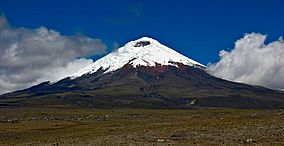Cotopaxi National Park facts for kids
Quick facts for kids Cotopaxi National Park |
|
|---|---|
|
IUCN Category II (National Park)
|
|

|
|
| Location | Ecuador Cotopaxi Province, Napo Province and Pichincha Province |
| Area | 33,393 ha (82,520 acres) |
| Established | 11 August 1975 |
| Governing body | Ministerio del Ambiente |
Cotopaxi National Park (Spanish: Parque Nacional Cotopaxi) is a special place in Ecuador. It's a protected area located about 50 kilometers (31 miles) south of Quito, Ecuador's capital city. This amazing park stretches across three provinces: Cotopaxi, Napo, and Pichincha.
The park is named after the famous Cotopaxi volcano. Its name means 'smooth neck of the moon' in the Quechua language. Cotopaxi is one of the highest active volcanoes in the world. It had a recent eruption that started in August 2015 and ended in January 2016.
Contents
Discovering Cotopaxi National Park
Cotopaxi National Park was created on August 11, 1975. It covers a huge area of 33,393 hectares (about 82,516 acres). The park is managed by the Ministerio del Ambiente, which works to protect its unique nature.
This park is a fantastic place to explore. It offers incredible views and a chance to see different types of plants and animals. Many people visit to hike, camp, and enjoy the stunning mountain scenery.
The Mighty Cotopaxi Volcano
The Cotopaxi volcano is the main attraction of the park. It stands tall and impressive, often covered in snow. Even though it's an active volcano, it's carefully monitored.
Its last major eruption was quite recent, showing that it's still a powerful force of nature. Scientists keep a close eye on it to ensure the safety of visitors and nearby communities.
Other Volcanoes in the Park
Cotopaxi National Park is home to more than just the Cotopaxi volcano. There are two other important volcanoes within its borders:
- Rumiñawi volcano: This volcano is located to the north-west of Cotopaxi. It is considered dormant, meaning it is not active right now but could erupt again in the future.
- Sincholagua volcano: Found to the south-east, Sincholagua is a historical volcano. Its last big eruption was in 1877.
These volcanoes add to the dramatic landscape of the park. They remind us of the powerful geological forces that shaped this region.
What You Can See and Do
Cotopaxi National Park is a great place for adventure and learning.
- Hiking and Trekking: There are many trails for different skill levels. You can hike around the base of the volcanoes or even try to reach higher altitudes.
- Wildlife Watching: The park is home to various animals. You might spot wild horses, llamas, deer, and many bird species. Keep an eye out for the Andean condor, a very large bird!
- Photography: The landscapes are breathtaking. You'll find amazing opportunities to take photos of the volcanoes, mountains, and unique plants.
- Camping: There are designated areas where you can set up a tent and spend a night under the stars, surrounded by nature.
Remember to always follow park rules and stay on marked trails to protect the environment and yourself.
Protecting the Park
Cotopaxi National Park is a protected area because it has special ecosystems and important wildlife. The park helps to conserve the unique plants and animals that live here. It also protects the sources of water for nearby communities.
By visiting responsibly, you help keep this beautiful place safe for future generations.
See also
 In Spanish: Parque nacional Cotopaxi para niños
In Spanish: Parque nacional Cotopaxi para niños


